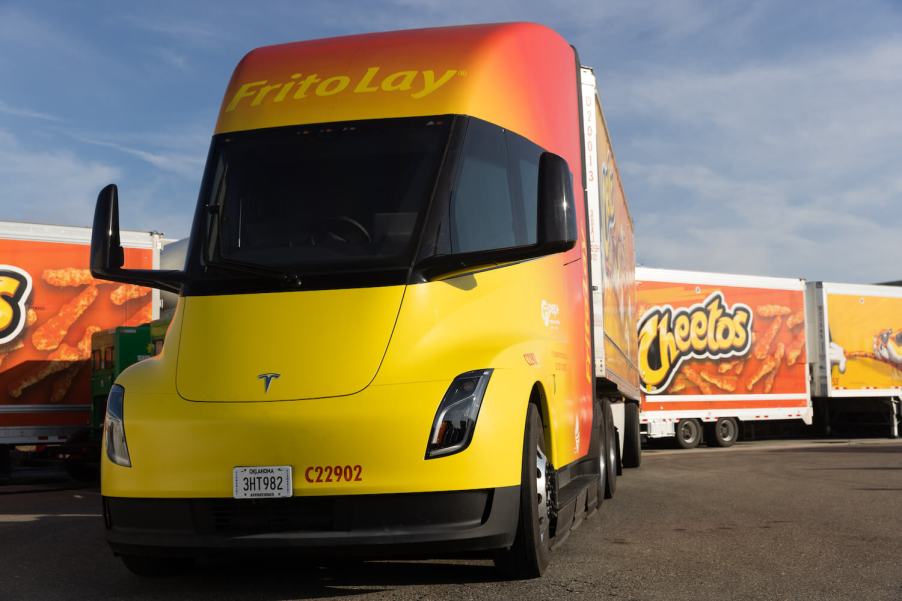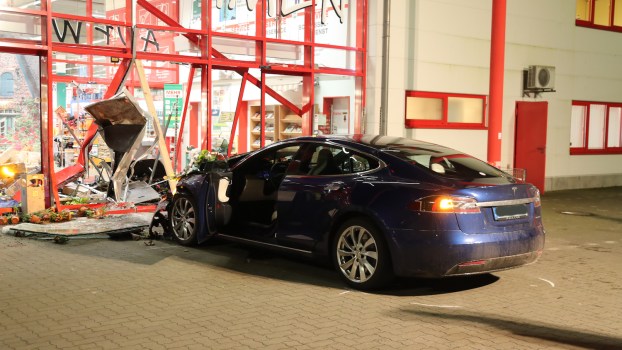
Why Are Tesla Semi-Trucks Stranded by the Roadside?
In December 2022, Tesla delivered its first semi-trucks to PepsiCo. Since then, keen-eyed Californians have noticed at least eight trucks seemingly nonoperational, either by the side of the road or being towed home. While Tesla has no media department, sources say the truck problem is as simple as the Semi’s infotainment screens going dead. If so, this would not be a first for Tesla.
Pepsi/Frito Lay bought the first Tesla Semis

On the evening of December 1st, 2022, Tesla hosted an event for its “Founder’s Series Semi” buyers and announced it was beginning customer deliveries. PepsiCo Vice President Mike O’Connell shared that the Tesla Semi–with its three carbon-wrapped electric motors and 1,000-volt charging system–could pull a trailer full of Frito-Lay chips 425 miles. So Pepsi bought the first round of $200,000 Tesla Semis to augment its truck fleet hauling products out of its Modesto, California plant.
PepsiCo immediately put its new Tesla trucks to use, hauling both Frito-Lay products and bottles of Pepsi products (though its range dropped to about 100 miles lugging around the soda). It seemed as if the Tesla semi-truck program was off and running. So imagine Tesla fans’ surprise when they began to notice these trucks seemingly broken down by the side of California roads, or even being towed home.
Teslarati reported eight incidents of a Tesla semi truck stranded or being hauled on a hook. Some folks speculated that the trucks must be suffering some severe powertrain issues not to be able to at least unhook from their trailer and limp home. And Tesla has not made a statement about the trucks.
Tesla semi-trucks may have an infotainment touchscreen issue

Teslarati tried to confirm the “breakdowns” and found a tow truck driver who reported hauling some of PepsiCo’s Tesla Semis to a “secret location” in Lathrop, California. A source close to Tesla’s operation in Modesto revealed to Teslarati that some of these semi-truck “breakdowns” are due to the infotainment screens failing. The technical cause of the problem may be a glitch in a software switch.
A Tesla semi-truck’s driver’s seat is in the center of its cab, flanked by two colossal touchscreens. The Semi driver operates all the truck’s systems (such as A/C) and reads all critical data, such as the Tesla’s speed and range, through these screens. Tesla semi-trucks have no switches or other hard controls.
Teslarati’s source reported that while some Tesla semi-trucks were driving, these screens flickered or even went dead. Even though these trucks were technically operational, the Semi drivers pulled over and parked the Tesla. The source said of the drivers, “They don’t know what to do…So they just pull over, and then they are towed.”
Tesla touchscreens are prone to failure

It would be best for the future of electrified transportation if this first-gen Tesla Semi problem is an easily-remedied software issue. But Teslas have a history of infotainment screen hardware failures–caused by quick-and-loose component sourcing.
Because of infotainment touchscreen failures, the NHTSA forced Tesla to recall and repair 134,951 Model S and Model X vehicles. The company complained that the screens weren’t “defective” because it knew these screens would only last five-six years and considered this acceptable.
In fact, Elon Musk once bragged that no automotive supplier offered a 17-inch touchscreen, so he instead sourced his Model S and X screens from an industrial product manufacturer. He discovered the hard way that a screen engineered to sit in a warehouse and operate a piece of machinery is very different than a screen engineered to live in a hot or cold car and restart multiple times every day.
Both PepsiCo and Tesla have yet to comment on the semi-truck problems. Tesla has also not made it clear whether the touchscreens in its semi-trucks are the same as those found in the Model X and Model Y.
Read more about Tesla’s infotainment touchscreen recall or watch CNBC’s look into the Tesla Semi in the video below:







